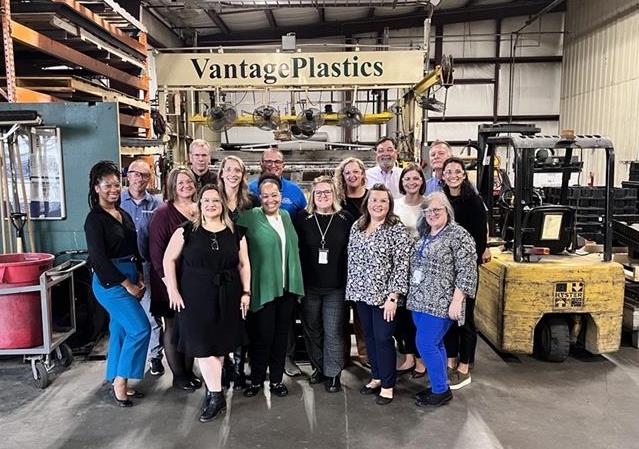
Members of the Michigan Health Improvement Alliance — in partnership with the Central Michigan District Health Department and local manufacturer Vantage Plastics — used a public health approach to reduce employee turnover and costs for Vantage. Photo courtesy of team.
Partnerships between public health and other sectors are critical to ensuring that public health efforts respond to communities’ needs and address complex health challenges that can’t be solved by one sector alone. While public health partnerships with housing, education, and health systems have become more common, especially in the wake of the pandemic, those with businesses are still rare.
Public health and business are inextricably linked. Businesses rely on healthy employees, consumers, and partners to reach their full potential and optimize their bottom lines. And communities need employment opportunities, stability, and equitable economic opportunity for all members to achieve their best health.
In 2022, the de Beaumont Foundation launched Innovative, Multi-Sector Partnerships for Community Transformation (IMPACT) in Public Health to catalyze much-needed but often overlooked partnerships between public health and businesses. As we conclude the IMPACT program, we reflect on the key lessons learned and what it takes to create and sustain collaboration between public health and the private sector.
Engaging the right partners is a balancing act.
Successful partnership work requires engaging the right stakeholders, but involving too many can lead to inefficiencies. Partnerships should conduct a stakeholder analysis to assess when and how to engage potential stakeholders. First, identify the top businesses in your community and determine whether there is overlap in your missions. Be sure to consider alignment across potential organizations on leadership, core values, mission, and a shared interest to stay focused on the collective outcome.
Before diving into work, partners need to cultivate relationships.
In the early stages of collaboration, it’s easy to jump into making to-do lists and assigning roles. But these tasks fall short without a shared understanding of the partnership’s goals and purpose. The strongest IMPACT partnerships were built on a foundation of trust and a common mission — sometimes forged through years of relationship-building. For those embarking on new partnerships, the first several meetings should focus on establishing team norms, which can be in the form of a team charter, a memorandum of understanding (MOU), and an agreed-upon way of working together. If possible, conducting these initial meetings in person fosters more productive brainstorming and reflection, and helps to create meaningful connections.

Members of the Massachusetts-based IMPACT team comprising the Quabbin Health District and local manufacturer Quabbin Wire & Cable Co., Inc. found success in appealing to both public health and business priorities. Photo courtesy of team.
Community members need to be intentionally engaged in partnerships.
Knowing which health issue to prioritize in a new partnership can be challenging. Instead of making decisions behind closed doors, invite community members to share ideas and identify where to direct attention. In Ware, Massachusetts, when the Quabbin Health District and local manufacturer Quabbin Wire & Cable Co. began their partnership, they didn’t know which public health concern to address first. They involved community members in this decision by conducting key informant interviews with HR leads from local and regional businesses to understand employees’ needs. The partnership team learned that their efforts should focus on addressing unmet mental health needs among their local workforces, including mental health, substance use, and access to care. Partnerships can keep their communities involved and informed throughout the process by creating opportunities for regular engagement and awareness, such as holding town halls and sending newsletters with project updates.
Partners succeed when they can speak one another’s languages.
Partners need to be able to frame their work in ways that resonate with the people they are seeking to engage. In making the case for partnerships involving public health and businesses, it’s important to connect healthy communities to a thriving workforce. When the Michigan Health Improvement Alliance and the Michigan District Health Department partnered with local manufacturer Vantage Plastics to advance public health in their shared community, Vantage Plastics shared that one of their top concerns was employee turnover. Similarly, one of the Alliance’s main issues was access to services. The Alliance successfully explained how increased access to mental and physical health services can prevent employee turnover, resulting in Vantage Plastics hiring a community health worker in their facility. Ultimately, bringing in an on-site community health worker saved nearly $1 million and decreased turnover by 18%, making a strong business case for continued partnership. Research from the Public Health Reaching Across Sectors (PHRASES) initiative provides more information on how businesses and public health can communicate effectively.
Creating a partnership brand can boost engagement and awareness.
In Mason City, Iowa, the Cerro Gordo County Department of Public Health and the Mason City Chamber of Commerce successfully established a wage supplement program to support childcare workers in their community. Known as the Child Care Works Collaborative, this partnership team increased awareness and visibility of their work by creating a partnership identity, logo, and mission statement. Not only did the Child Care Works Collaborative’s brand increase community members’ awareness — and ultimately, support — of their mission, unifying around a brand also made the team feel like they were part of something bigger than each of their organizations alone and boosted their motivation.
Building partnerships between public health and businesses requires dedicated project management.
Teams that hired a project coordinator to manage the partnership, set agendas, and hold space for regular meetings made the most progress toward their goals. Led by a full-time project coordinator, the Minneapolis Health Department, the utility company Xcel Energy, and local government officials partnered to support a growing network of community-serving resilience hubs to address disparate climate impacts in low-income neighborhoods. The team attributes their success in part to having a dedicated project coordinator, who led calls, shared knowledge among project partners, facilitated conversations, convened grant meetings, hosted events, and tracked new funding opportunities.
To learn more about de Beaumont’s partnerships work, visit our programs page and explore our resources on developing partnerships.




